One of the 40 Unesco recognised World Heritage sites in the country, Hampi is evocative of the pomp and glory of the Hindu kingdoms of the pre-Mughal era which has brought visitors from across the seas to marvel and write about it

Virupaksha Temple
A designated Unesco World Heritage Site, Hampi (pop.3,300) — sited in the southern state of Karnataka — is fast emerging as a popular heritage and leisure tourism destination. The Hampi ruins are evocative of the pomp and glory of the Hindu kingdoms of the pre-Mughal era which brought visitors (most famously Nobel laureate and author V.S. Naipaul) from across the seas to marvel and write about them.
Recently five adventurers and travel writers re-explored the exotic ruins, sited on the banks of the tranquil River Tungabhadra. Perhaps, the flowing river which provided unlimited fresh water in this rocky terrain prompted Vijaynagara kingdom rulers to choose this location to establish their capital. Set amidst massive boulders and craggy hills, the ruins sprawl over an area of 26 sq. km and are among the 40 Unesco recognised World Heritage sites in the country.
Hampi was the capital of the ancient Vijayanagara Empire which controlled the Deccan Plateau for over 200 years from 1336-1565 AD, and reached its zenith during the reign of Krishnadevaraya, its most famous emperor. Following the death of Krishnadevaraya in 1529, the neighbouring Muslim Bahamani rulers coalesced and attacked Hampi. The invading armies ran amok in the town, destroying its beautiful temples and monuments and left the once grand city in ruins.
Thus far the Archaeological Survey of India (ASI) has identified and restored 57 major monuments in Hampi and has installed signboards and information plates to highlight their significance. Easy to read, digitally printed maps have also been placed in strategic locations amidst the ruins to help tourists find their way to monuments of their choice. ASI has also trained and accredited several multi-lingual guides for the convenience of tourists. Their fees vary from Rs.50 an hour to Rs. 1,000 per day, depending on the size of the group and monuments covered.
For those who would rather wander about the ruins on their own, enterprising businessmen have started renting bicycles (Rs.100-150 per day) and motorbikes (Rs.250-300 per day). Autorickshaws driven by self-styled local guides are also an option.
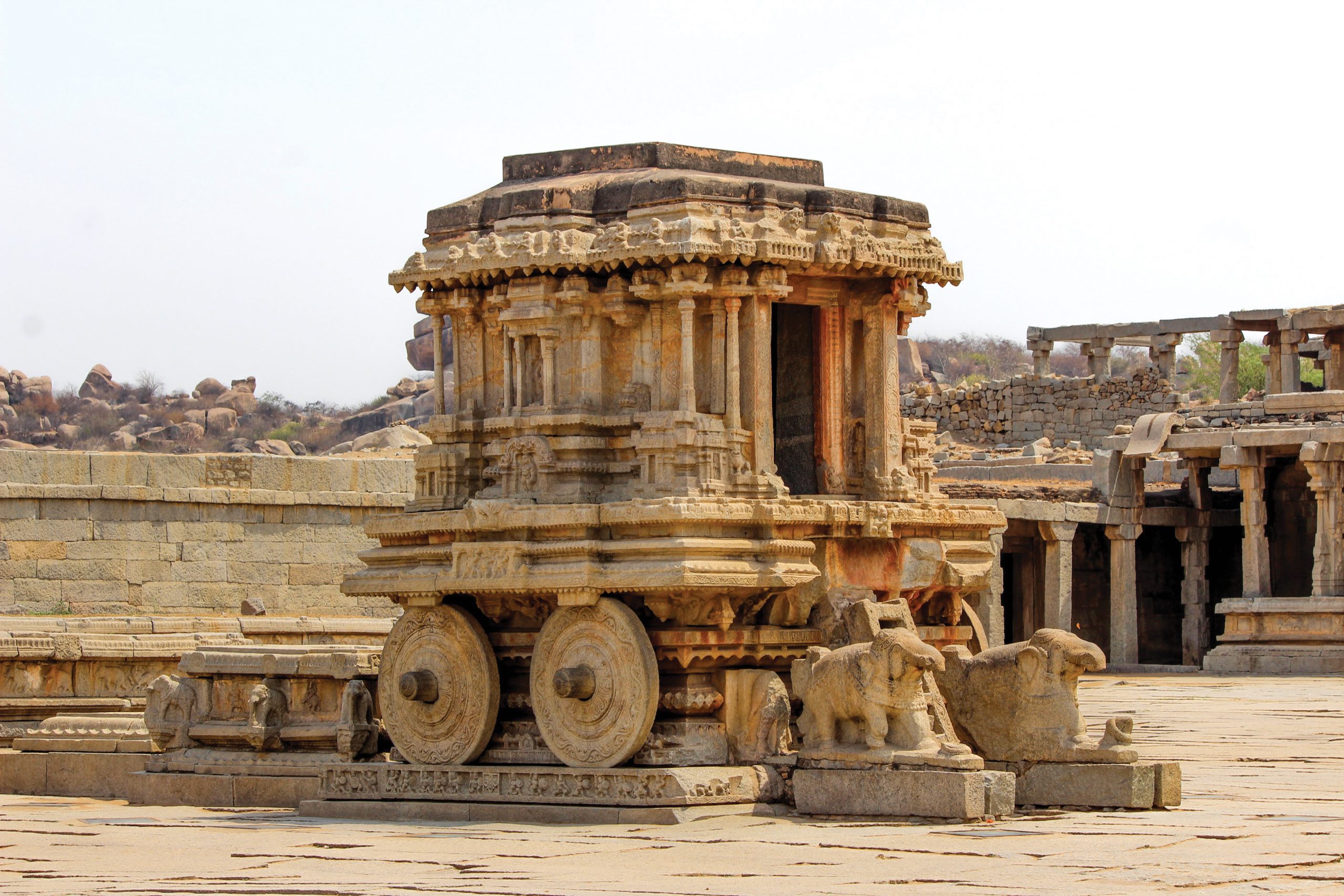
Vittala Temple Stone Chariot, Hampi
Day 1 — Drive to Hampi
The 355 km journey from Bengaluru to Hampi situated in the Vijayanagara district (formerly in the Ballari district) of Karnataka began on October 12 at 8.15 p.m. The first 25 km out of the garden city was a tortuous jostle through narrow traffic-clogged streets. The next leg, a stretch of about 200 km on the National Highway-4, upto the famous fort-city of Chitradurga was fast and smooth thanks to the toll highway built at a cost of Rs.457 crore under the Central government’s Golden Quadrilateral project. The remaining 120 km stretch on National Highway-13 which links Hampi via Hospet with Chitradurga was also smooth and we reached Hampi at 4 a.m.
Day 2 — Temple tour in Hampi’s main bazaar
After a short nap and a refreshing swim in the Tungabhadra, we set out to explore Hampi. The first stop was the Virupaksha temple in the main bazaar area, Hampi’s largest operational temple complex. The massive mahadwara (main entrance) leads into a vast open courtyard. Built entirely of stone, the temple is neatly divided into various sections including a housing block for employees, a kalyanamantapa (marriage hall) to perform religious ceremonies, a large water tank, flower garden and administrative area.
The most striking feature of this 15th century temple is a small dark cubicle behind the sanctum sanctorum. An inverted shadow of the imposing rajagopuram (entrance cupola) is reflected on the wall opposite — evidence that the pinhole camera technique and the properties of refraction and dispersion of light were perfected and practiced in India well before they were known in the western world. The tallest structure in the ancient town — the rajagopuram of the Virupaksha temple is clearly visible from as far as Kamalapuram 5 km away.
After exploring the Virupaksha temple, we climbed the adjacent Ratnakuta hill which is strewn with several small abandoned temples displaying highly refined sculptured pillars and friezes. Contiguous to Ratnakuta is Hemakuta hill, dotted with temples and large dolmens. Conspicuous among the buildings on this hill is the Sasivekalu (mustard seed) Ganesha, a 12 ft tall monolithic image of the elephant god enshrined in an open pillared pavilion. Consecrated in 1506, the statue depicts lord Ganesha seated in the ardhapadmasana yogic posture bearing a tusk, goad, noose and a bowl of sweets in each of his four arms.
With the sun at its apogee, we took a break and ate our packed lunches while resting in the cool shadows of the ruins. Following a 90-minute break, we traversed a rough footpath to the Achyutaraya temple about 500 metres from the main bazaar. This sprawling temple complex with the most decorative carvings was built by SalakarajuTirumaladeva, chief officer of king Achyutaraya, the predecessor of Krishandevaraya.
We capped the day’s activities with a visit to the top of Mathanga hill. Climbing a steep flight of 600 steps which weave and wind their way between massive boulders and through caves was well worth the effort. The view from the summit, of the sunset flooded crimson surreal ruins, is truly awesome.
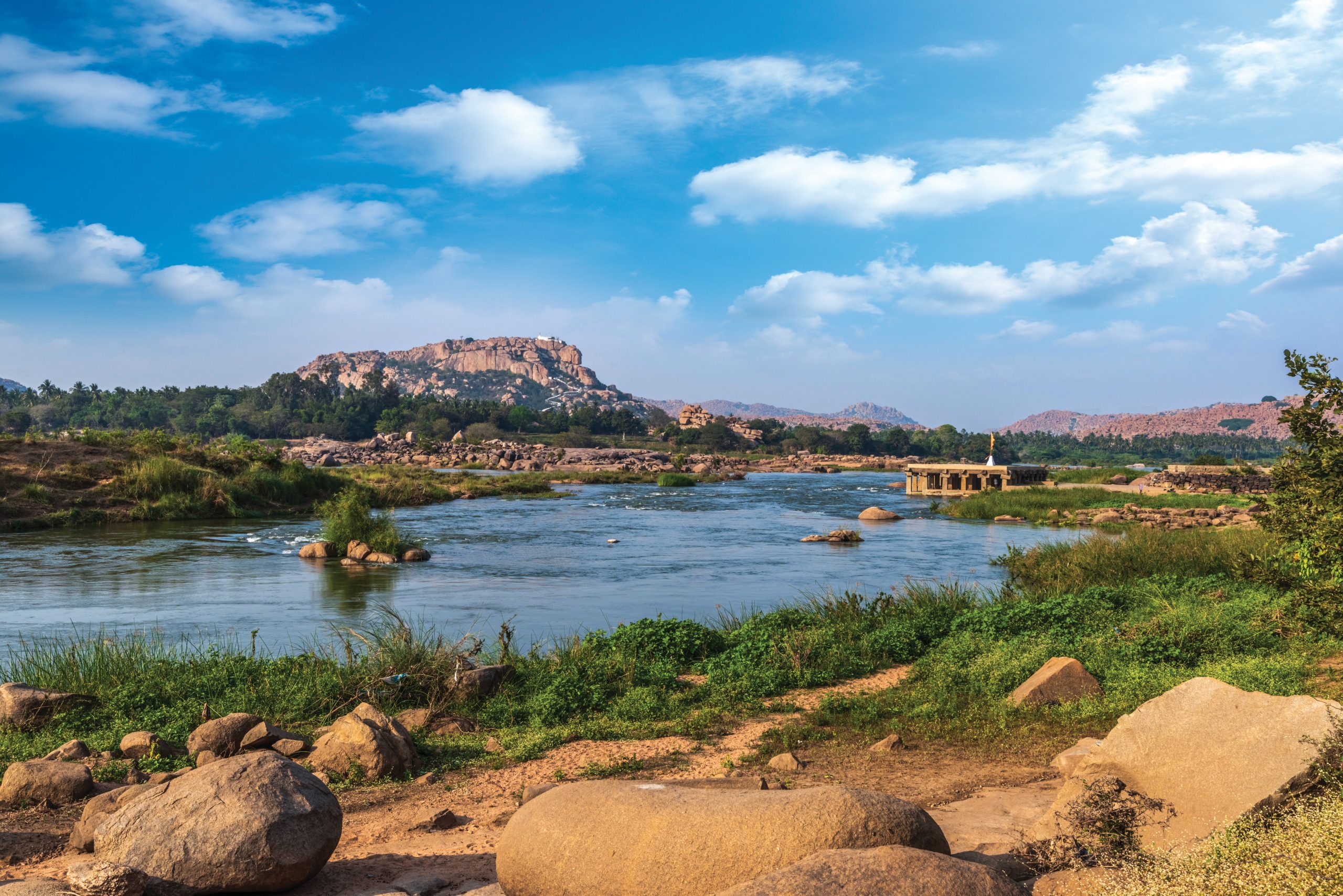
Tungabhadra River
Day 3 — Tour of Royal Enclosure and monoliths
Venturing deeper into Hampi’s relics on the third day, we took in the magnificent 22 ft tall monolithic statue of Lakshmi Narasimha (the half-lion-half-man incarnation of Lord Vishnu), seated atop the giant coils of the seven-headed serpent god Adishesha. Consecrated in 1528 on the orders of Krishnadevaraya, the sculpture originally depicted the divine consort Lakshmi seated in Narasimha’s lap. It is popularly believed that the monolith was mutilated and the Lakshmi idol hacked to pieces by raiding armies. An idol of Lord Shiva, known as Badavalinga, stands in the immediate vicinity. The 9 ft tall lingam carved out of shiny black granite rises out of a pool of clear water.
Our next stop was Hampi’s famous Vittala temple, 5 km by road from the main town. There are two ways of reaching this temple — a 3-km cross-country trek through rocky hillocks or by road. We opted for the former — a decision which provided a memorable experience. En route were monuments far removed from the tourist circuit — PurandaraMantapa on the banks of river Tungabhadra and the King’s Balance where it is believed the Vijayanagara princes were weighed against gold and silver ornaments received as tribute from subordinate kingdoms.
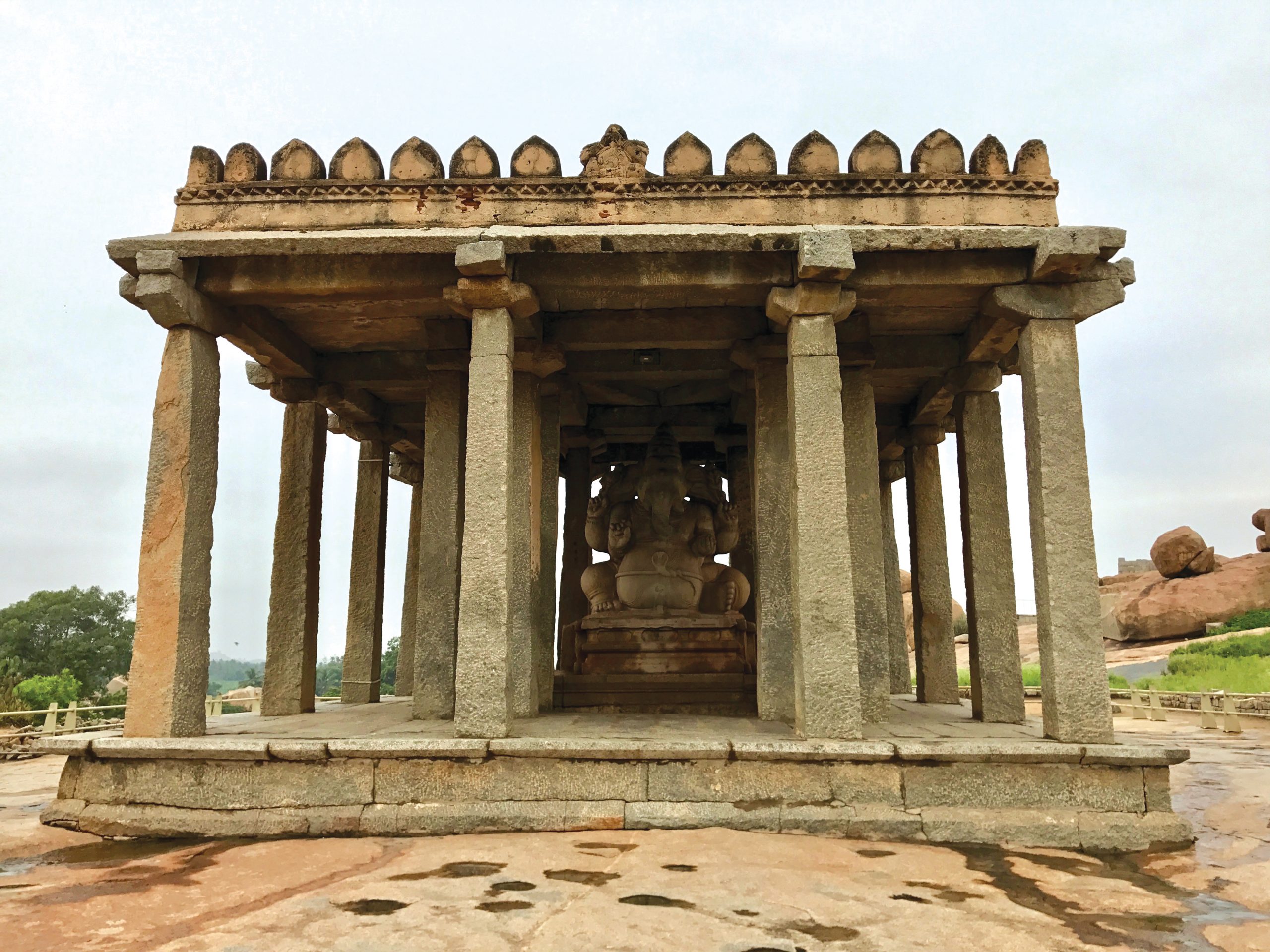
Sasivekalu Ganesha
The Vittala temple is perhaps the finest example of Vijayanagara architecture. Originally constructed by king Devaraya II (1421-1440), it was further embellished during Krishnadevaraya’s reign (1509-1529). The temple comprises an impressive rajagopura and two hundred pillared mantapas with attractive carvings depicting Vishnu in his numerous incarnations. The pillars hewn out of single granite blocks with carved friezes, produce musical notes when gently tapped, prompting the mantapa to be christened the (Temple) Hall of Musical Pillars.
Yet perhaps the most breathtaking structure in Hampi is the amazing Stone Chariot installed inside the Vittala temple. This huge chariot carved out of stone and 22-ft high, is testimony to the skills of the stone carvers of the Vijayanagara empire. The chariot is especially striking at night when it is bathed in soft lighting installed by ASI.
A 2-km walk from the stone chariot leads to the grand Hazara Rama temple, originally built by Vijayanagara kings for private worship. The temple which stands within a walled enclosure exudes an air of elegant serenity when the soft moonlight illumines its beautiful friezes, even as its rock sculptures glisten in the rays of the morning sun. The relief sculptures on the walls and temples depict scenes from the epic Ramayana.
Our next stop was the Royal Enclosure, which contains the Lotus Mahal, elephant stables, Zenana enclosure, the Mahanavami Dibba and the stepped tank. The Zenana Enclosure or the queens’ quarters is an eclectic blend of Hindu and Islamic architecture, surrounded on all sides by tall watchtowers — most of them in a state of ruin. The elegant Lotus Mahal evokes a floating palace on a full moon night. Close by are the Elephant Stables, a majestic row of 11 domed stalls, with arched connecting doorways. One of the better preserved palaces here has been converted into a museum which displays an impressive collection of royal artefacts including small idols, weapons, coins and paintings.
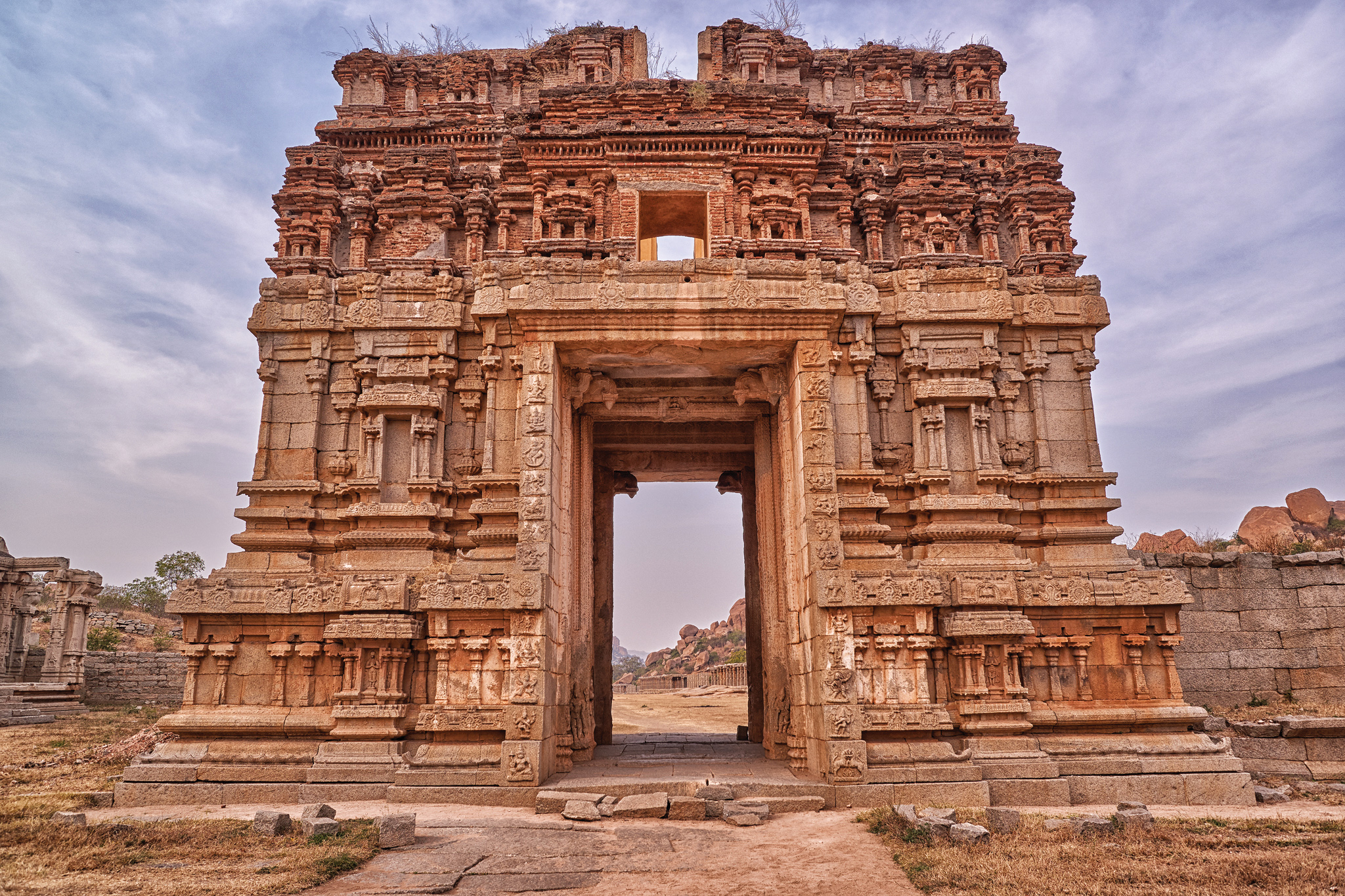
Achyutaraya Temple entrance
An enormous platform known as Mahanavami Dibba with a floor area of 5,300 sqft, served as a viewing platform for kings, consorts and royal officers of the festivities below. Rising 30 ft above ground level, it is decorated with intricately carved horses, soldiers, a couple of foreign looking dignitaries, and a scene showing girls frolicking in water. The vantage view of the Tungabhadra as it silently winds its way through the rocky cliffs is enchanting. Another must-see monument here is the Stepped Tank, about three metres deep, into which water was fed by a series of stone channels, an example of expert engineering techniques developed several centuries ago.
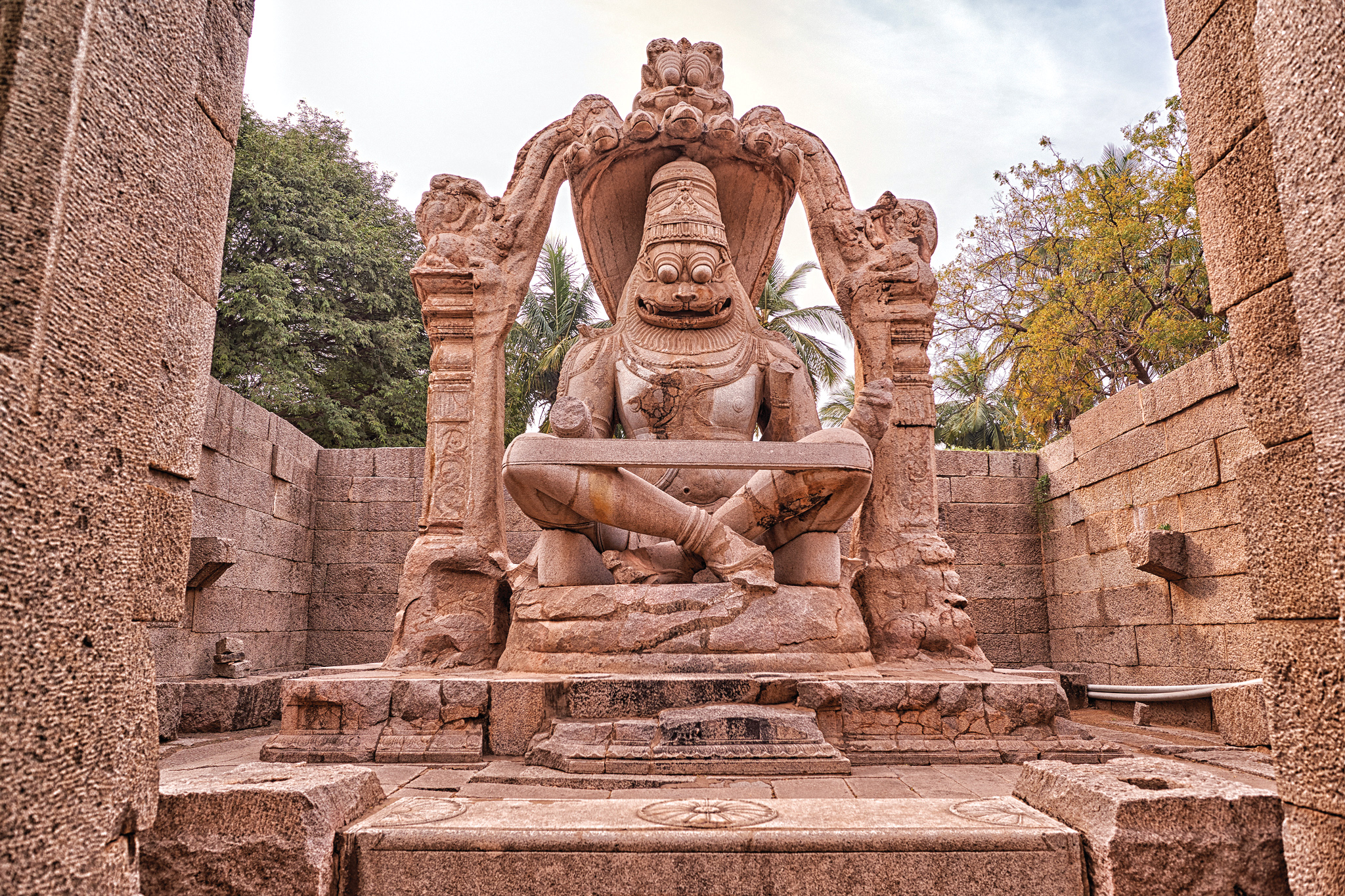
Lakshmi Narasimha Temple
Day 4 — Anegondi
On the last day of our excursion we set out early morning for Anegondi, 35 km by road, reluctantly refusing the option of crossing the river on coracles, plied by local fishermen. The main landmarks of this village are the Ranganatha temple, Huchchappayana Matha, Pampa sarovara and Anegondi Fort.
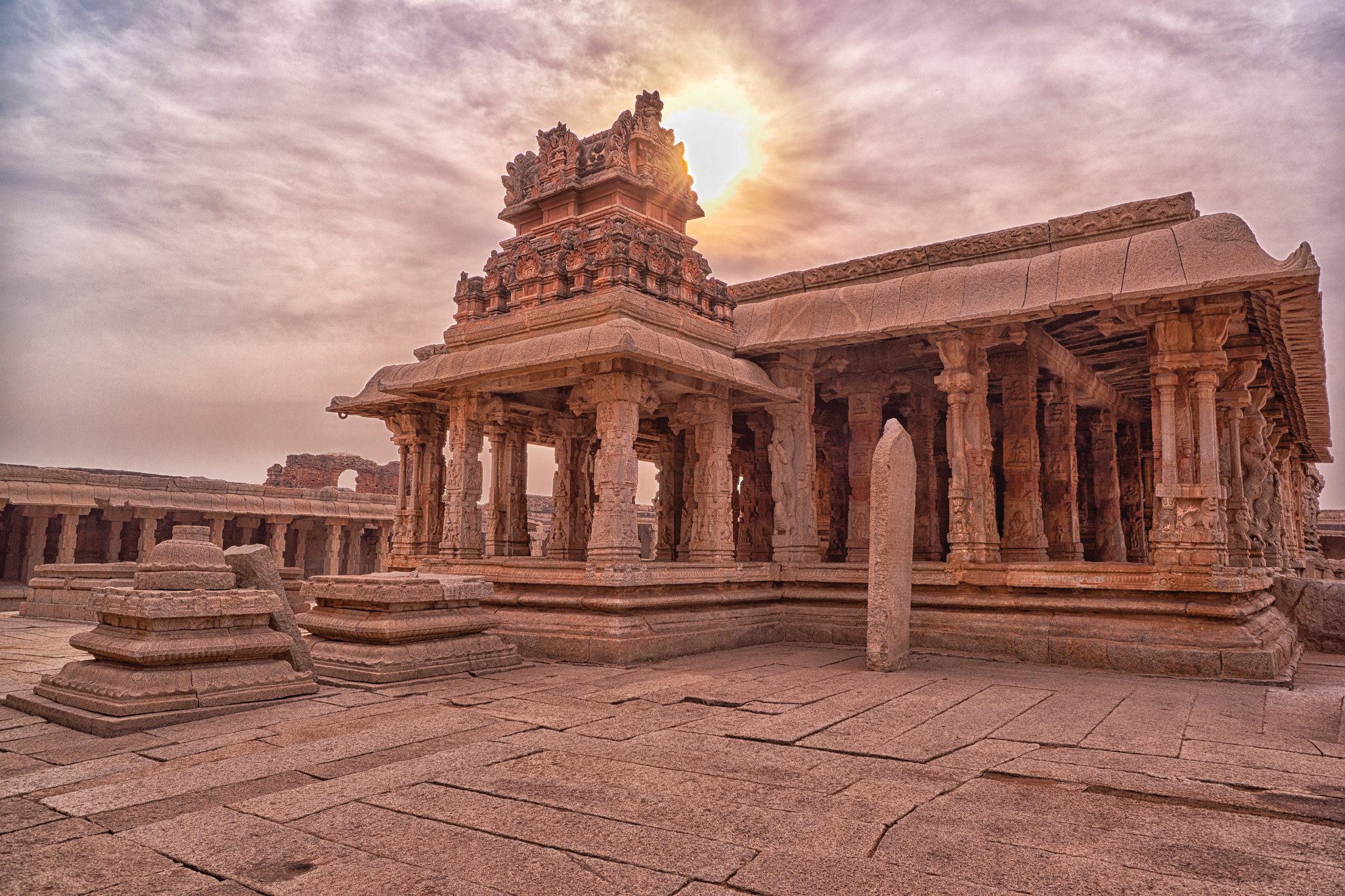
Krishna Temple
The sprawling Ranganatha temple is sited in the centre of Anegondi from where we visited the Pampa Sarovara, a large water body set amid rocky hillocks and believed to be the source of the river Pampa. A short coracle ride took us to the Nava Vrundavana, a venerated temple housing nine shrines dedicated to Madhva seers (theerthas) — Padmanabha, Kavindra, Vageesha, Govindawadiyar, Vysaraya, Raghu-varya, Srinivasa, Rama and Sudhheendra — dating between the 12th-16th centuries.
Returning from Nava Vrundavana by coracle, the next stop was Anjanadri Hill, some 6 km from Anegondi. This rocky
formation topped by a Hanuman temple, presents a striking visual when viewed from Hampi. Surprisingly the entire hill including the temple, is managed by self-styled, ganja smoking, Hindi-speaking sadhus aka godmen who continuously recite verses from the Ramayana. The best feature of Anjanadri is the marvelous view it offers of the surrounding countryside. Amidst rugged cliffs, the mighty Tungabadhra flows calmly offering fantastic sunset and sunrise vistas.
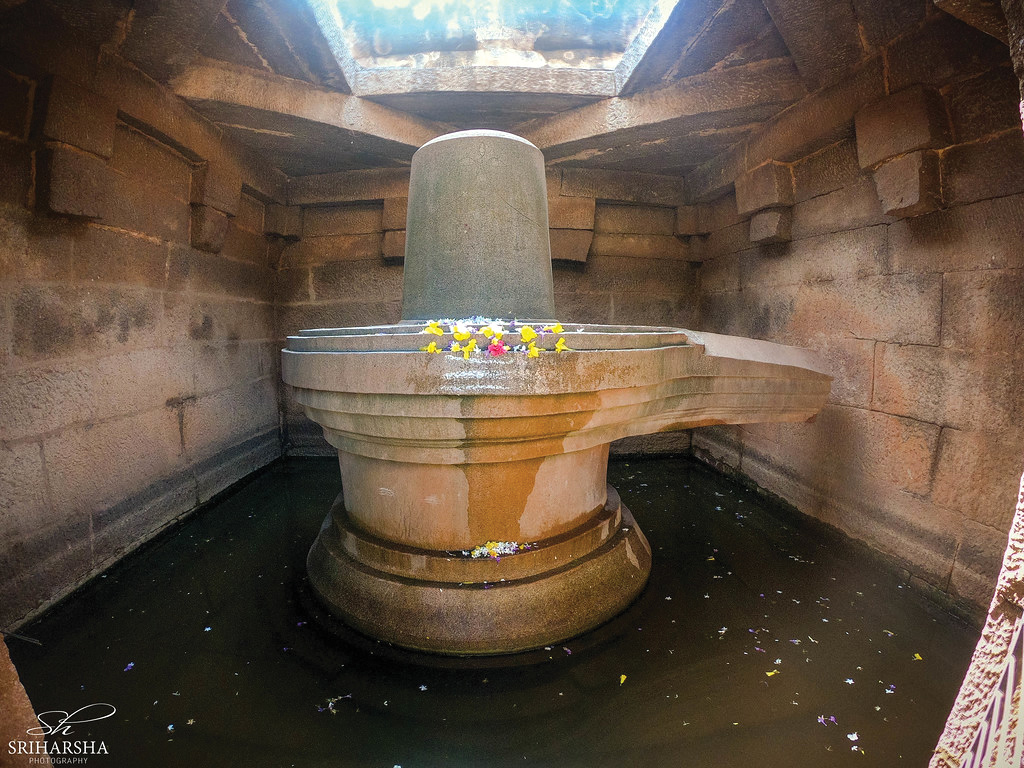
Badavilinga Temple
On the return journey to Bangalore, the only stop en route was the Tungabhadra Dam, Hospet, about 25.8 km from Hampi. It encloses waters spread over 400 sq km, making it the largest multi-purpose dam in Karnataka, generating 72 MW of electricity annually and irrigating several thousand acres of land in Ballari, Raichur and Chitradurga districts. Recreation facilities in the form of fountains, scenic walks, park, an aquarium and a musical fountain are on offer.
Our four-day sojourn in the ancient ruins of Hampi made us aware that there’s more to this world heritage site than is generally depicted and promoted. Though the ruins span only 26 sq km, the list of monuments identified by ASI features 57 temples and other monuments of which we had visited only a few. A good reason to revisit this psychologically uplifting seat of an ancient empire, testimony of the architecture and town planning capabilities which we are heir to.
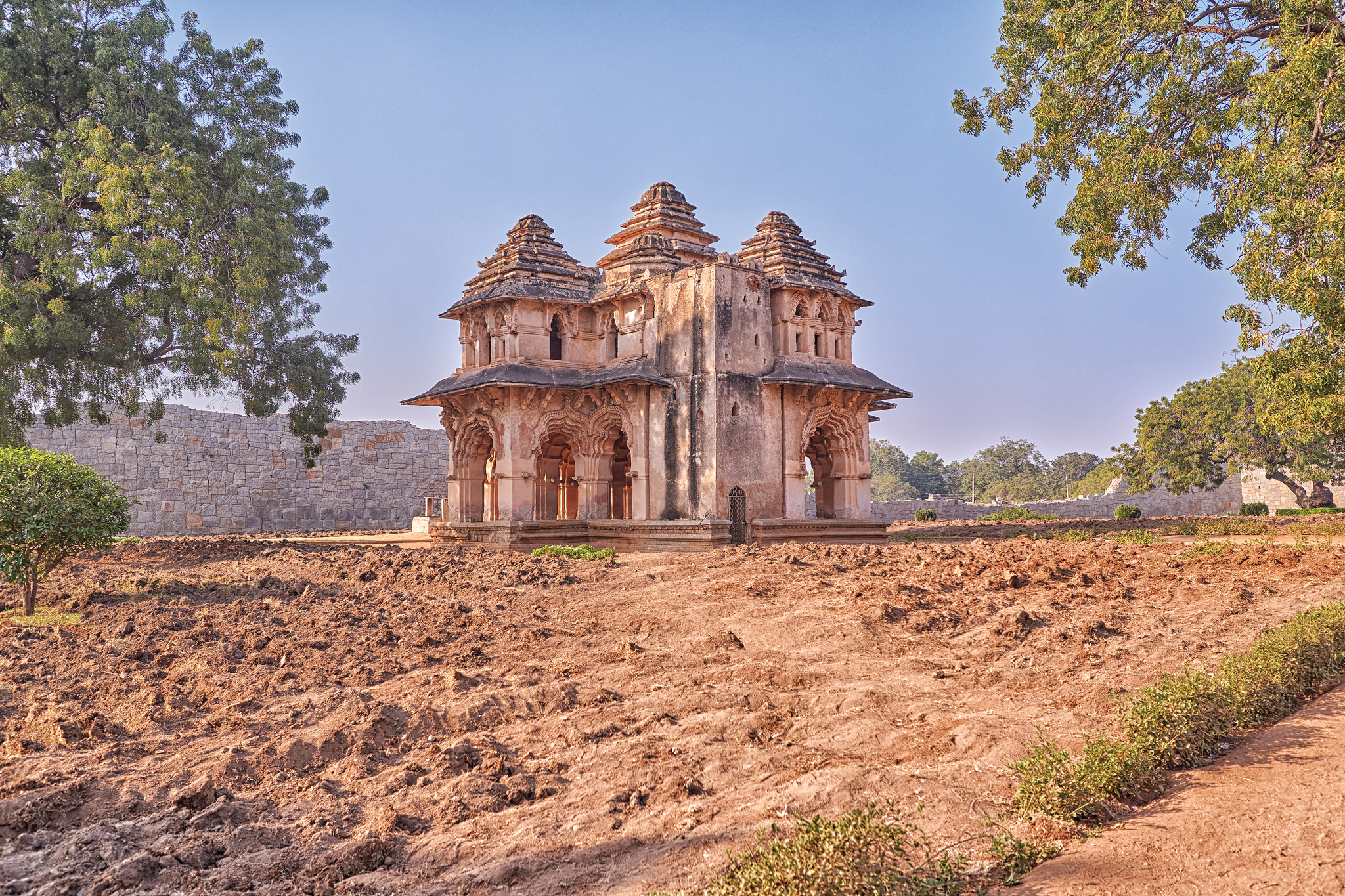
Lotus Mahal
Getting there
Hampi is sited in central Karnataka and is well connected by rail, road and air.
Rail. The nearest railhead is Hospet, 13 km by road from Hampi.
Road. Regular bus services are available from Bengaluru to Hospet.
Air. Ballari (59.2 km) is the nearest airport; other convenient airports are Belagavi (264 km) and Bengaluru (362 km).
The best time to visit Hampi is from September to February. Summer months are unpleasant with temperatures soaring above 40oC.
Accommodation options. Hampi offers numerous hotel options. They include:
High-end: Evolve Back, Hampi (Rs.26,271 per night), Welcome Heritage Shivavilas Palace Hampi (Rs.22,000), Hyatt Hampi (Rs.8,620). Mid-range: Heritage Resort Hampi (Rs.6,489), Whispering Rocks Hampi Hills by StayApart (Rs.6,840), Kishkinda Heritage Resort (Rs.3,447). Budget: Magic Rock Homestay (Rs.2,350), Om Shiva Guest House (Rs.2,350), Akash Homestay (Rs.1,381).
Eating out in Hampi. You may be surprised to learn that food is not an issue here. Numerous small eateries and cafes line the road in the main bazaar catering to every taste — South Indian, North Indian, Chinese, Tibetan, Italian — and include ice cream parlours, fresh fruit stalls etc. This is probably because every second traveller to Hampi is a foreigner.
For more information about Hampi visit https://www.karnatakatourism.org/.
Also Read:























